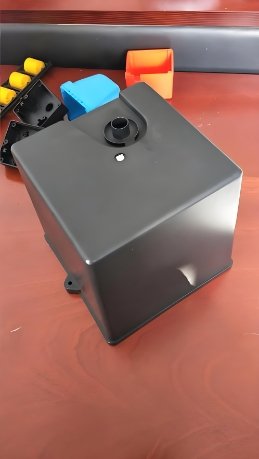
A Real-World Success Using Electronic Injection Molding and Skilled Mold Makers
Designing and producing a plastic housing for a new IoT device is a major challenge. The casing must protect sensitive electronics, support internal parts, and present a professional look to users. When a tech startup needed a custom plastic housing for their smart home IoT controller, they partnered with an experienced Mold Maker skilled in Electronic Injection Molding. The result was a highly functional and attractive enclosure, delivered on time and within budget.
This case study shows how planning, tooling, and smart decisions led to success. It also highlights how Electronic Injection Molding and expert Mold Makers turn a 3D design into a production-ready product.
Project Background
The client was a growing startup in the smart home industry. They had developed an IoT device that connects lights, locks, and sensors. Their engineering team had a 3D model of the internal PCB and a rough concept for the outer housing. However, they lacked experience in plastic part design and needed full support from mold design to mass production.
They contacted a trusted Mold Maker with a strong track record in Electronic Injection Molding, especially for small electronic enclosures. After reviewing the concept, the Mold Maker helped refine the design for manufacturability and suggested material options suited for IoT applications.
Challenges in the Project
Creating a custom housing for an IoT device brings unique challenges. The team faced several key issues:
- The housing had to allow Wi-Fi and Bluetooth signals to pass through (no metal content).
- It required tight tolerances to support internal PCBs and connectors.
- The surface needed to be clean and scratch-resistant, with an optional logo.
- The enclosure had to support wall mounting and cable routing.
- A snap-fit design was requested to avoid screws.
The Mold Maker analyzed these needs carefully. With their deep understanding of Electronic Injection Molding, they proposed solutions to meet each challenge while keeping tooling costs low.
Design Optimization by the Mold Maker
The client’s initial CAD file had undercuts, thick wall sections, and uneven parting lines. These issues would create defects like sink marks, warping, and poor surface finish.
The Mold Maker’s engineering team stepped in. They modified the model while keeping the product’s look and function intact. Their improvements included:
- Adding draft angles for easy part release
- Reducing wall thickness to 2.0mm for better cooling
- Smoothing transitions to avoid stress points
- Placing ribs strategically to add strength
- Modifying snap-fit features to improve durability
These updates made the housing more suitable for Electronic Injection Molding, reducing cycle time and improving part quality.
Material Selection
Material choice is critical in Electronic Injection Molding. The Mold Maker reviewed several thermoplastics with the client. Together, they chose PC/ABS for its balanced performance:
- Strong impact resistance
- Good appearance and finish
- Stable under temperature changes
- Suitable for indoor environments
- RF-transparent for signal flow
This decision helped the project move forward smoothly, with predictable molding results.
Mold Design and Tooling
With the part design finalized, the Mold Maker began building the mold. The mold was a two-cavity tool with a cold runner system, optimized for 300,000 shots. Key mold features included:
- Interchangeable inserts for logo variations
- Venting in snap-fit areas to prevent gas burns
- Ejector pins positioned away from cosmetic zones
- Texturing on the outer surface for a premium feel
During mold fabrication, the Mold Maker used CNC and EDM machines to achieve tight tolerances. A thorough mold trial was completed to test filling, ejection, and cooling.
Electronic Injection Molding Production
Once the mold passed trial testing, it moved into production. The Electronic Injection Molding process was fully documented. Key process settings included:
- Injection speed and pressure optimized for flow control
- Mold temperature held at 80°C for part consistency
- Drying of PC/ABS to avoid bubbles or streaks
- Visual inspections and dimensional checks every 50 cycles
The Mold Maker ensured stable conditions throughout. Using their automated press and quality system, they delivered 10,000 units in the first run, with a 99.5% pass rate.
Quality Control Measures
Quality control was central to this project. The Mold Maker followed strict inspection standards:
- Incoming material testing and drying logs
- In-process visual checks for sink marks and warping
- Dimensional checks with fixtures and calipers
- Functional tests of snap fit and mounting points
Each batch was labeled and traceable. Final packaging included ESD-safe bags to protect the parts before assembly.
Final Outcome
Thanks to the deep knowledge of Electronic Injection Molding and years of experience as a Mold Maker, the project was a success. The client praised the part quality, surface appearance, and structural performance.
The device went to market ahead of schedule. Customer feedback highlighted the housing’s sleek look and sturdy feel. The Mold Maker received follow-up orders for new color variants and an extended model line.
Key Takeaways
This project proves that the right Mold Maker makes all the difference in electronic part production. Their ability to guide the process—from early CAD review to full production—turned a startup’s idea into a real-world product.
Here are the main lessons:
- Partner early with a Mold Maker who understands Electronic Injection Molding
- Optimize your part for manufacturability before building a mold
- Choose materials based on mechanical and environmental needs
- Use detailed quality checks to maintain consistency
Whether you’re a startup or a large brand, choosing the right partner is key. A smart Mold Maker helps you avoid common problems, reduce costs, and launch products faster.
